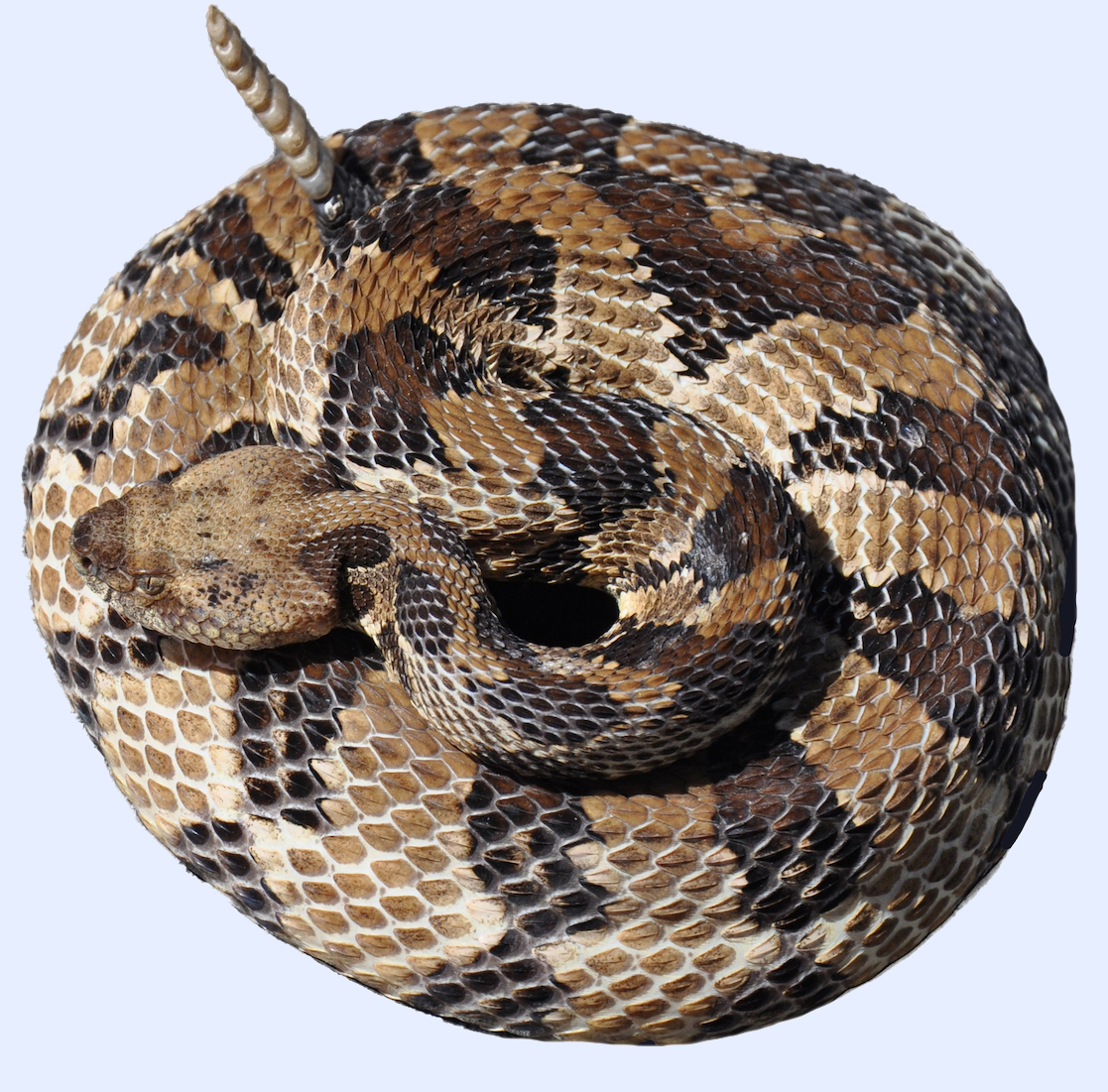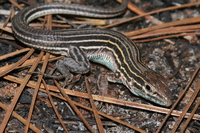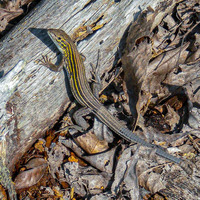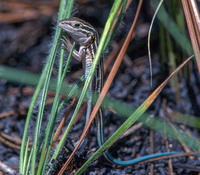Taxonomy
Class: ReptiliaOrder: SquamataFamily: TeiidaeSynonym: Aspidoscelis sexlineata
Taxonomic Comments: Aspidoscelis sexlineatus is one of nineteen species in this genus recorded in North America north of Mexico (SSAR, 2017). Most occur in the West and only A. sexlineatus occurs in our area.Species Comments: Three subspecies exist but only the nominate form, A. s. sexlineatus , the Eastern Six-lined Racerunner, occurs in the Southeast and east of the Mississippi River.Aspidoscelis is masculine (Steyskal, 1971), so the correct specific epithet is "sexlineatus " rather than "sexlineata " (Tucker et al., 2016; Walker et al., 2021).
Identification
Description: Although sometimes confused with skinks, based on their possession of longitudinal pale lines, this species is easily recognizable in a good quality photo showing nearly any part of its body.Field Marks: This is a long, slender lizard, whose combination of six pale stripes and granular scales over most of its body distinguishes it from all of our other lizards. Skinks, in contrast, have only five pale lines at most and their scales are smooth and shiny rather than granular or plate-like. Males and females of A. sexlineatus are similar in appearance but males have a bluish wash on their undersides whereas females are whitish or pinkish below (Palmer and Braswell, 1995). Juveniles have similar markings to the adults but have pale bluish tails, similar to those of juvenile skinks but not as bright.Morphological Features: The top of the head is covered with large scales and the tail and undersides are covered with plate-like scales. Details about the scalation of this species are given in Palmer and Braswell (1995). The maximum head-body lengths are: 3" (75 mm), males; and 3" (76mm), females (Palmer and Braswell, 1995). These measurements are similar to those of the Five-lined Skink, but the tails of Racerunners are typically longer.Technical Reference: Palmer and Braswell (1995)Field Guide Descriptions: Beane et al. (2010); Powell et al. (2016)Online Photos: Google iNaturalist GBIF Observation Methods: This active, diurnal species can be commonly seen in suitable habitat, particularly in sandhills in the Coastal Plain. Usually, this species is first noticed after it has been disturbed, taking off at a high speed. Unlike skinks, it escapes along the ground rather than climbing the nearest tree. Fitch (1958) found, however, if an observer avoids sudden movements and maintains a distance from a racerunner, that it may behave in what appears to be a normal manner.
Distribution in North Carolina
Distribution Comments: Six-lined Racerunners are found in all three physiographic provinces in the state but are absent in the lower lying portions of the Coastal Plain, in the northern mountains, and portions of the northern Piedmont. We have a number of records from the barrier islands, but this species is limited in the mountains to elevations below 3,000 ft (Palmer and Braswell, 1995).Distribution Reference: Palmer and Braswell (1995); NCMNS Herpetology Collection Database (accessed 2023-02)County Map: Clicking on a county returns the records for the species in that county.
Key Habitat Requirements
Habitat: Six-Lined Racerunners are ground-dwelling species requiring well-drained soils and fairly open, well-insolated glades, barrens, or disturbed areas with sparse ground cover (Palmer and Braswell, 1995; Beane et al., 2010). Clear-cuts can be used by this species as well as roadside and railroad rights-of-way (whether or not roadsides represent population sinks needs to be determined).Environmental and Physiological Tolerances: This species is highly tolerant of hot, dry conditions, as indicated by the presence of its populations on the barrier islands. On the other hand, its range in North Carolina indicates that it is limited by cold or wet conditions. It is rarely, if ever, found in densely shaded forests.Adaptations to Natural Disturbances: This species benefits from frequent burning of its habitats (Mushinsky, 1985; Steen et al., 2013). Unlike the Southeastern Five-lined Skink, which co-occurs with this species in sandhill scrub habitats, Racerunners prefer wide open areas, which are maintained by frequent fire, rather than areas with deep leaf-litter, as in the skinks, which are rediced when fires become too frequent (Mushinsky, 1985, 1992).Biotic Relationships: Six-lined Racerunners feed predominantly on arthropods, particularly grasshoppers, spiders, and caterpillars (Burt, 1928; Fitch, 1958). In a study conducted in Georgia, Hamilton and Pollack (1961) found that orthopterans -- grasshoppers and crickets -- were found in 61% of the individuals they sampled, followed by spiders in 41%, caterpillars in 29% and beetles in 27%. The only non-arthropod prey they identified were snails, found in just 9% of the specimens examined. Snails were also reported by Burt.
Life History and Autecology
Breeding and Courtship: Mating takes place in the spring. According to Fitch (1958), males actively search for females but will chase any individuals -- males or females -- that they encounter and attempt to mate with them. Males develop more bluish undersides during the mating period and may elevate their bodies in aggressive displays towards other males. No elaborate courtship behaviors appear to exist, however. Reproductive Mode: Fitch (1958) found evidence that there may be more than one clutch produced per year and he also noted that females can become reproductive during their first year. Females lay their eggs in shallow burrows they dig in sand or sawdust; several females may use the same areas for nesting. In North Carolina, Palmer and Braswell (1995) found clutch sizes to vary between one and 10. Laying takes place mainly from May to June and hatching occurs mainly in July and August but as early as June and as late as September.Terrestrial Life History: Individuals of this species occupy home ranges, which Fitch (1958) thought were fairly small for such active species, with two that he estimated only 0.20 and 0.25 acres in extent. While faithful to these ranges, Fitch also noted that shifts in range also can occur, particularly where habitat becomes newly opened up, providing suitable areas of occupancy for this species. Within the home ranges, burrows appear to be important resources. Fitch noted that this species is well-adapted for digging its own burrows but that it will also make use of rodent burrows where available. These burrows are used for escape from heat during the day and for sleeping overnight. They are also used for escape from predators. Although possibly used for only short periods of time, Fitch also noted that they are defended against incursions from con-specifics. Deeper burrows are used for hibernation.
General Ecology
Adverse Environmental Impacts
Habitat Loss: This species has lost much of its original habitat due to conversion of woodlands and natural barrens for development or agriculture, although this particular species is able to make some use of ruderal areas, including the roadsides and edges of croplands.Habitat Fragmentation: As is true for all of our reptile species, Six-lined Racerunners are highly vulnerable to road mortality and both highway construction and development in general has greatly fragmented the upland habitats used by this species.
Status in North Carolina
NHP State Rank: S5Global Rank: G5Populations: Although this species is widespread in the Coastal Plain, it is unclear how fragemented their habitats are. In the Lower Coastal Plain in particular, sandridges are more limited than they are close to the Fall-line, and how well racerunners are able to move between these separate units is unknown. The same is true for populations in the Piedmont and mountains.Protected Lands: Fort Bragg and the Sandhills Game Land represent large, well-connected blocks of the sandhills habitats used by this species; populations in these areas are probably completely secure.Environmental Threats: Increased heat, droughts, and fires associated with global climate change may favor this species, at least over the short run. If climate increases beyond what is currently experienced in the range of this species in southern Florida, however, they may need to shorten their activity periods, with possible adverse effects on their viability.Status Comments: Based on the likely security of this species in Fort Bragg alone, this species is unlikely to become extirpated from the state. Individual populations, however, are vulnerable to loss given the suitability of open, upland habitats to human uses. Suppression of natural fires also degrades their habitats to some degree.Stewardship: Use of prescribed burns is recommended as a way of maintaining the open, sparsely-vegetated landscapes required by this species.
Photo Gallery for Aspidoscelis sexlineatus - Six-lined Racerunner 28 photos are shown. Recorded by: Stephen Hall Recorded by: R. Newman Recorded by: Erich Hofmann and Kayla Weinfurther Recorded by: Cassie Crawford Recorded by: Erich Hofmann Recorded by: Travis McLain Recorded by: G. Schneider Recorded by: Erich Hofmann Recorded by: L.Eckart Recorded by: Travis McLain Recorded by: Hunter Phillips Recorded by: W. Morris Recorded by: D. Harvey Recorded by: K.Trotter Recorded by: J. Mickey Recorded by: Erich Hofmann and Alex Fisher Recorded by: ASH, NEW Recorded by: Cooksey, B. Recorded by: K. Bischof Recorded by: Chris Helms Recorded by: ASH Recorded by: E. Corey, P. Aycock, and R. Maynard Recorded by: E. Corey, P. Aycock, and R. Maynard Recorded by: ASH Recorded by: M.Windsor Recorded by: Gary Perlmutter, Dakota Perlmutter Recorded by: J. Shimel Recorded by: Newman, Randy

 »
» 




 »
» 


